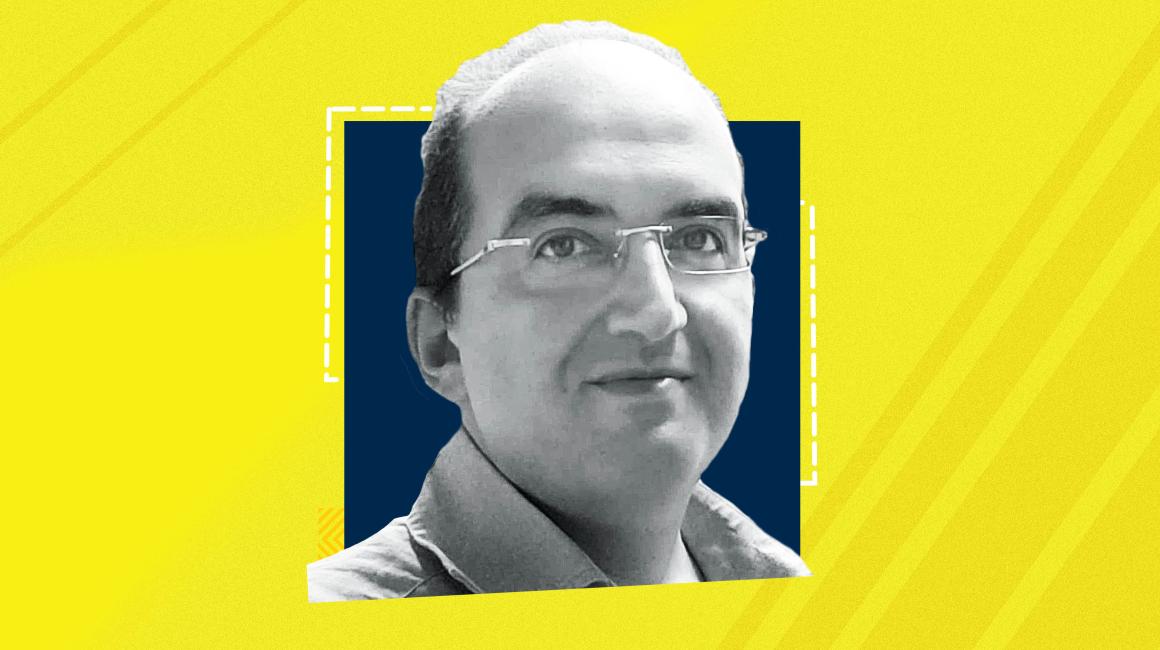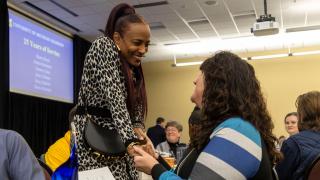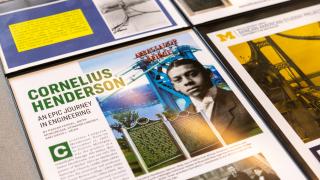
Even when people or places seem very different, UM-Dearborn’s Center for Arab American Studies Director Wessam Elmeligi said there’s a way to find common ground. Take, for example, Egypt’s Temple of Kom Ombo and Washington D.C.'s Thomas Jefferson Building.
There’s an age difference of 2000-plus years. The styles are vastly different. And the two structures are located more than 6,000 miles — or, as the ancient Egyptians would have written, 21-plus million cubits — apart. So what do they have in common? Elmeligi, who was recently named the new director of the university’s Center for Arab American Studies, said they represent the greatness that comes out of creative ideas, human expression and an openness to learning new things.
Elmeligi also said they reinforce how humanity is connected across time and space. In the U.S. Library of Congress’ Thomas Jefferson Building, the 19th-century painted dome ceiling shares the names of nations integral to the evolution of civilization. Egypt is among them.
“I had visited the temples in Luxor and Aswan (Egypt) as a teenager and I recall seeing the hieroglyphs and statues carved in stone and feeling awestruck. For the U.S. to include Egypt's contributions to written records next to America’s contribution to science, they must have felt similarly,” said Elmeligi, a native Egyptian with dual American and Egyptian citizenship. “It was a reminder that people may be from different places, live at different times or have different beliefs, but we are all connected.”
As CAAS director, Elmeligi wants to help people see these throughlines. The first Arab American studies center in the U.S. when it began in fall 2000, CAAS focuses on ways to increase awareness of Arab American history and the experiences of Arab, Middle Eastern and Muslim Americans.
Born in Lebanon to Egyptian parents, Elmeligi attended primary school in Morocco and earned a college education at the University of Alexandria in Egypt, where he also worked as an associate professor. He first came to the U.S. participating in the Summer Institute at the University of Louisville in Kentucky, then again as a Fulbright scholar-in-residence at Macalester College in St. Paul. He returned to Egypt, where he taught English at Pharos University in Alexandria until 2012. Elmeligi then moved to the United States for a teaching role at Macalester College again before coming to UM-Dearborn in 2019.
He said the CAAS leadership role gives him the opportunity to offer creative outlets and promote Arabic literature, music, poetry, painting and more, with the goal for UM-Dearborn students, faculty and staff – and the broader metro area – to share experiences, create connections and build community.
Since joining UM-Dearborn’s faculty, Elmeligi has taught Arabic literature and language courses, developed the Arabic Translation Certificate and the Comparative Literature Certificate, and serves as the program director for UM-Dearborn’s new Arabic Studies major. Also involved with the center during this time, Elmeligi said he’s been impressed with the strong leadership at the CAAS helm by longtime Director Sally Howell and Interim Director Pauline Homsi Vinson.
Among the center’s recent programs and accomplishments:
- CAAS earned a 2023 Michigan Humanities Award for Community Impact Partner of the Year.
- The center continues to have an active podcast, Seen Jeem, which highlights the work of Arab-American writers.
- “Hadha Baladuna: Arab American Narratives of Boundary and Belonging” (Wayne State University Press 2022), co-authored by UM-Dearborn history Professor and former CAAS Director Sally Howell, earned a Midwest Book Awards gold designation in the category of nonfiction-anthologies.
Elmeligi said he wants to continue the center’s creative work and its strong connections with Arab American organizations like ACCESS and the Arab American National Museum. He’s also looking to develop new partnerships with organizations like the Arab American Center for Culture and Arts. In addition, he's hoping to connect with other centers and departments on campus and beyond, collaborating on various events. He aims to make the Center more student oriented, as well.
He’s also looking to expand on the center’s work by addressing stereotypes through education and artistic expression. For example, Elmeligi said a common literary stereotype is that Arabic authors do not produce science fiction. “They think about ‘The Arabian Nights,’ sultans and belly dancers. I’ve heard people say science fiction writing is too technologically advanced,” he said. “But there have been Arabic authors since the ninth century who have projected ideas for different futures and there are talented Arabic sci-fi writers out there today. That’s one stereotype that I’m focused on changing.” To help do that, Elmeligi plans to bring award-winning science-fiction graphic novelist Saladin Ahmed to campus. Ahmed is a writer for Marvel Comics, focusing on Marvel characters Black Bolt and Daredevil.
Stereotypes lead to naive microaggressions, racism and harmful encounters toward Arab populations, Elmeligi pointed out. Looking at his two countries of citizenship — Egypt and the U.S. — Elmeligi said both populations have more to unite them than divide. “We are countries who have had difficult experiences, but those have not broken us. We are countries with a noticeable sense of kindness. Both are protective of their identities, but also show the ability to appreciate others. And all humans experience the same feelings, have successes and failures, and want to be cared for and connected,” he said. “I do celebrate differences too because they create a beautiful mosaic. But I wish we would stop glossing over our similarities.”
Another way Elmeligi challenges stereotypes is by finding creative ways to give his students immersive experiences. In his Arabic language courses, Elmeligi used virtual reality to connect UM-Dearborn students with students at universities in Algeria and Morocco. Through the platform Tabadul, Elmeligi’s classes practiced speaking standard Arabic language with college students on the other side of the world while also learning about day-to-day life in Middle Eastern and North African countries.
“My goal is to foster a learning environment to bring out the creative potential in my students and empower them to think independently,” he said. In his classes, students present creative projects that range from songs and short films to calligraphy and painting.
And that goes back to the importance of ideas, human expression and an openness to learning new things.
Elmeligi said there are civilizations dating back thousands of years that show how different groups peacefully coexisted and brought out the best in each other’s talents. One example: Muslims, Christians and Jewish people lived together on the Iberian Peninsula — which is present day Portugal and Spain — during the medieval period. They learned from one another, shared materials and created exquisite artwork, literature and architecture.
“Multiculturalism has been done before and it will be done again. The good news is that we’re better equipped for it today. We have the Internet, which gives an almost-immediate way to connect. Research shows the importance of representation. And we recognize the role of cultural centers and organizations when it comes to promoting education and expression,” he said. “ I am humbled to be the person chosen to lead this effort in our community. Helping people make connections to better understand each other may take some work, but history has shown us that the results can be beautiful.”
Article by Sarah Tuxbury.



